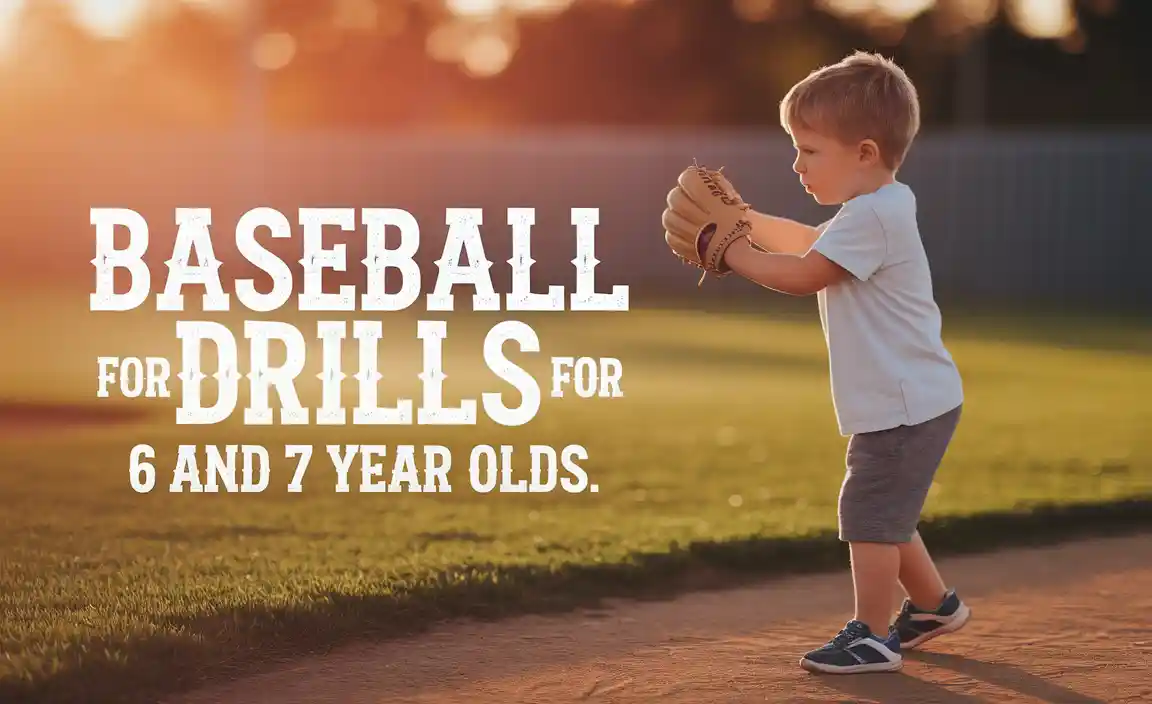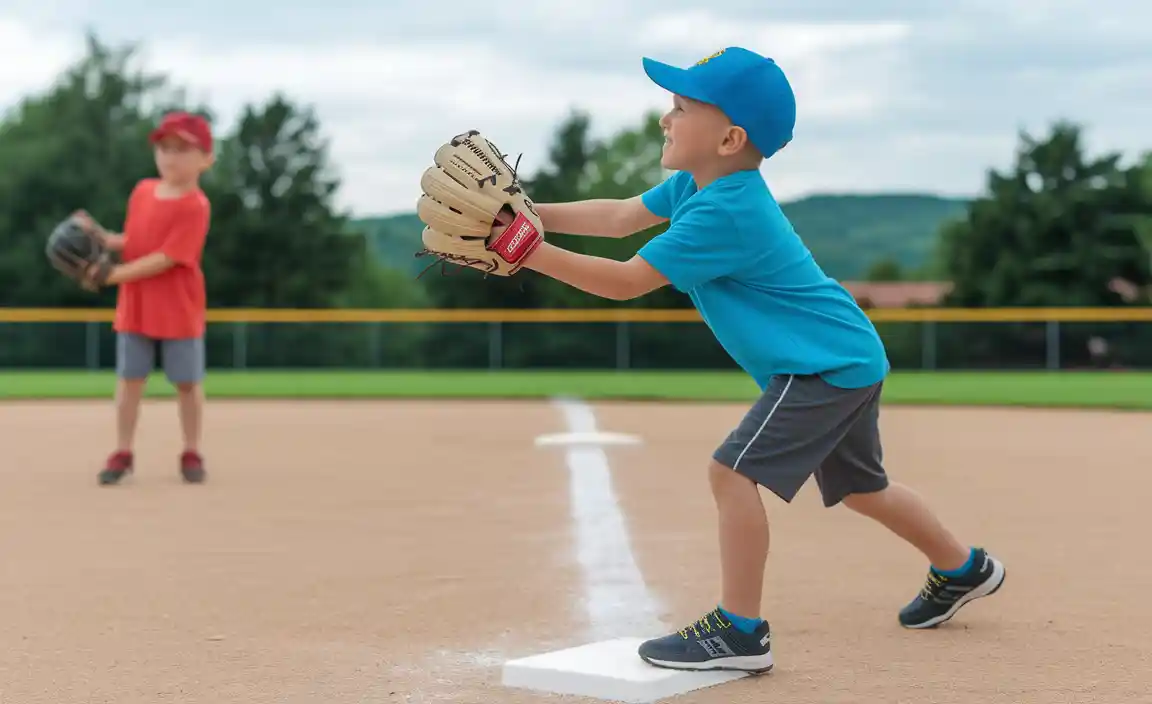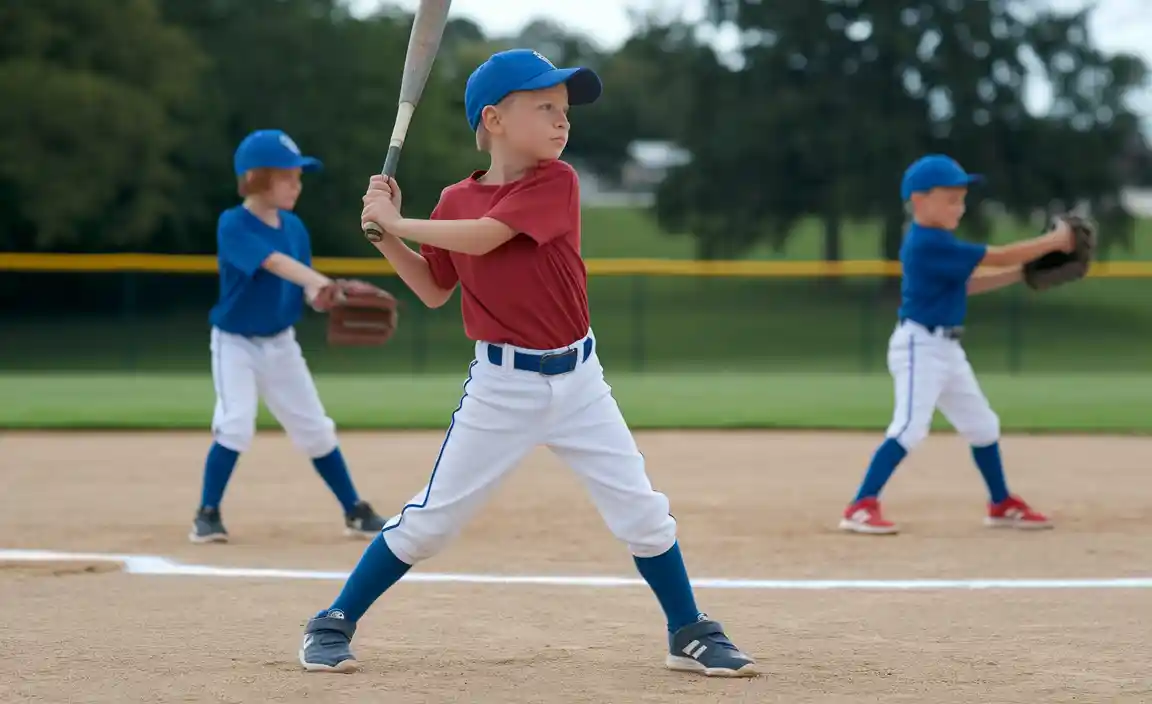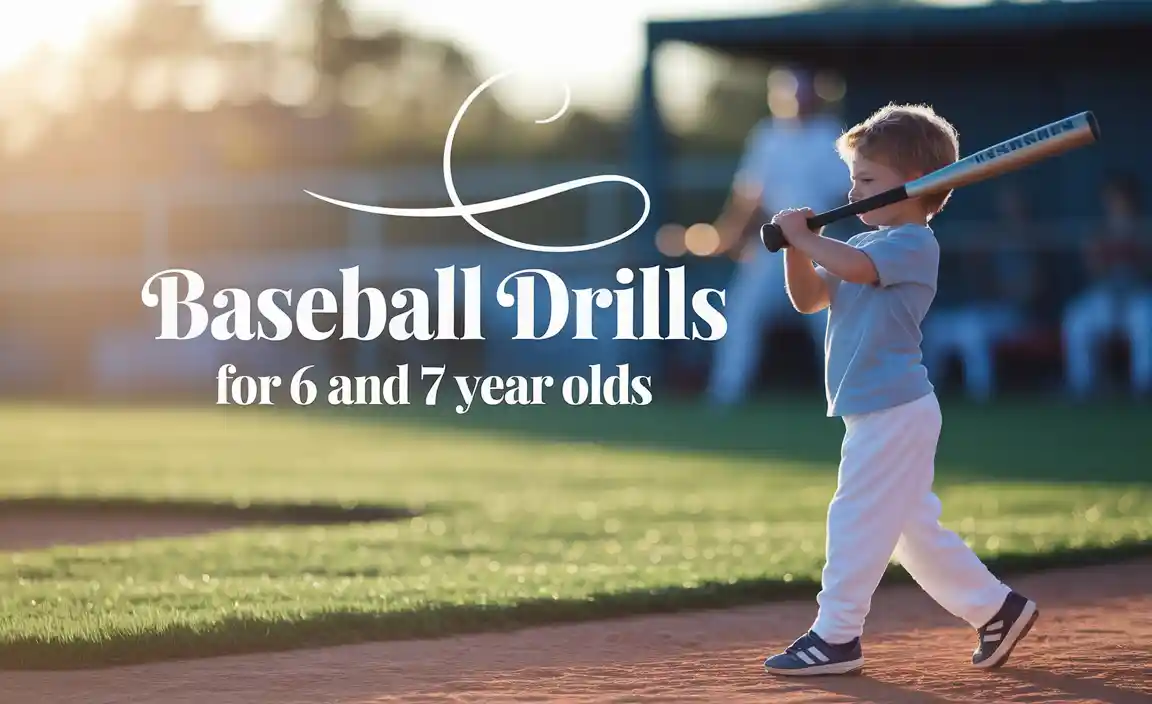Baseball drills for 6 and 7 year olds should focus on fun, fundamental skill-building, and positive reinforcement. These drills emphasize engagement through play, making learning enjoyable and effective for young players.

Getting young kids excited about baseball is all about making practice feel like play. At 6 and 7 years old, children are developing important motor skills and learning to follow instructions. Sometimes, parents and coaches worry about how to teach the basics of baseball without making it feel like a chore. Many aspiring young ballplayers might struggle to stay focused or understand complex techniques. The good news is, with the right approach, baseball drills can be incredibly fun and effective for this age group. We’ll walk through some proven drills that build skills while keeping smiles on faces.
Why Fun Drills Matter for Young Ballplayers
For 6 and 7 year olds, the primary goal of any baseball activity should be enjoyment. When kids have fun, they are more likely to pay attention, try their best, and develop a love for the game. Drills designed for this age group should be short, engaging, and celebrate effort and improvement rather than just perfect execution. This phase of development is crucial for building a positive association with sports. It’s less about mastering advanced techniques and more about understanding the basic movements, developing hand-eye coordination, and learning to be part of a team. A fun-first approach also helps prevent burnout and keeps them eager for the next practice.
Essential Baseball Gear for 6 & 7 Year Olds
Before diving into drills, ensuring kids have the right, age-appropriate equipment is key. Proper gear not only helps with skill development but also ensures safety.

The Basics: What They Need
- Youth Baseball Bat: Look for lightweight bats made of aluminum or composite materials. Ensure the bat is the correct length and weight for your child; they should be able to swing it comfortably without straining. A 30-inch, 17-20 ounce bat is often a good starting point.
- Youth Baseball Glove: A glove that fits well is crucial. It should be snug enough to hold the ball but not so tight that it’s uncomfortable. Many youth gloves are “pre-broken-in” to make them softer and easier to close.
- Helmet: A batting helmet with a faceguard is essential for safety when batting or running the bases. Ensure it fits snugly.
- Baseball Pants and Cleats: Comfortable athletic pants (or baseball pants) and cleats will help with traction and protection.
- Baseball: A standard youth baseball is perfect for most drills.
Having the right equipment can make a big difference. For instance, a well-fitting glove makes it easier for them to catch the ball, boosting confidence. Similarly, a bat they can handle properly allows them to practice their swing more effectively. Resources like Little League’s bat regulations can help parents understand what’s permissible as kids progress.
Fundamental Baseball Skills to Focus On
At this age, we focus on the building blocks of baseball. These skills form the foundation for future development.

Catching and Fielding
This involves tracking the ball, getting in front of it, and securing it. For young players, it’s about developing soft hands and confident movements.
Throwing
Proper arm motion, accuracy, and a strong, follow-through are key. It’s important to teach them to throw with their fingertips, not their palms.
Hitting
Learning a basic stance, a controlled swing, and making contact with the ball. Focus on eye-hand coordination and a smooth motion.
Base Running
Understanding how to run to first base, around the bases, and the concept of tagging up.
Fun Baseball Drills for 6 & 7 Year Olds
Here are some engaging drills that incorporate fun elements while working on these fundamental skills. Aim for short, high-energy sessions that rotate through different activities.

Drill 1: “Wiggle Worms” (Fielding & Catching)
This drill is fantastic for teaching kids to get in front of the ball and use their hands. It’s simple, requires minimal instruction, and always gets laughs.
- Have players lie down on their stomachs in a line, facing the coach or parent about 10-15 feet away.
- Gently roll or toss a soft baseball towards each player, aiming for their chest area.
- The player’s job is to get their “wormy” body in front of the ball and use their glove to catch it.
- Encourage them to extend their arms and use their glove to secure the ball.
- Praise them for getting in front of the ball, even if they don’t catch it perfectly.
Why it works: It exaggerates the need to block the ball and uses a fun animal analogy. The low-to-the-ground aspect makes it feel less intimidating.
Drill 2: “Throwing Tag” (Throwing Accuracy)
This game combines the fun of tag with throwing practice. It’s a great way to work on accuracy and receiving throws.
- Divide players into pairs, about 15-20 feet apart.
- One player (the “thrower”) has a ball. The other player (the “receiver”) stands with their glove ready.
- The thrower calls out the receiver’s name and attempts to throw the ball directly into their glove.
- If the receiver catches it, they become the thrower, and the previous thrower becomes the receiver.
- If the ball is dropped, the receiver does a quick, fun action (like 3 jumping jacks or a silly dance) and then becomes the thrower.
- Rotate partners after a few minutes.
Why it works: It’s competitive but low-stakes, encouraging players to focus on accurate throws and secure catches in a dynamic way.
Drill 3: “Super Slow Motion Swing” (Hitting Mechanics)
This drill helps young hitters feel their swing path and develop a better sense of timing and coordination without the pressure of hitting a fast pitch.
- Set up a tee with a soft-toss baseball.
- Instruct the child to take a “super slow motion” swing. They should move as slowly as possible throughout the entire swing, from their stance to their follow-through.
- Focus on them seeing the ball, keeping their eyes on it, and making contact.
- Assist them in slowing down their movements if needed. The goal is to feel the rotation and the bat path.
- Make it a race to see who can do the slowest, controlled swing while still making contact.
Why it works: It builds muscle memory and awareness of their body during the swing. It helps them concentrate on the fundamental movement rather than just trying to hit the ball hard.
Drill 4: “Relay Races” (Base Running & Teamwork)
Relay races are always a hit and can be adapted for base running. This encourages speed and understanding of bases.
- Set up a simple base path from home plate to first base, or a longer path involving multiple bases.
- Divide players into teams and have them line up behind the starting point.
- On “go,” the first player in each line runs to the designated base (e.g., first base), touches it, and runs back to tag the next player in line.
- The next player then runs the same course.
- The first team to have all players complete the relay wins.
- Adapt it by having them practice rounding the base or receiving a “throw” at the base before running back.
Why it works: It’s inherently competitive and fast-paced, making base running exciting. It reinforces the concept of running to and touching bases.
Drill 5: “Balloon Ball” (Hitting & Hand-Eye Coordination)
This is a super fun way to practice hitting without the sting of a bat connecting with a ball. It’s excellent for developing hand-eye coordination.
- Use a lightweight foam bat and a large, inflated balloon.
- Have players stand at a comfortable distance from the person holding the balloon (or hang the balloon from a string).
- The person holding the balloon can gently toss or float it to the hitter.
- The hitter’s goal is to make contact with the balloon using the foam bat.
- Encourage players to watch the balloon all the way to the bat.
Why it works: Balloons move slower and are much easier to hit, reducing frustration. It builds confidence and hand-eye coordination in a playful environment.
Drill 6: “Critter Catch” (Fielding & Agility)
This drill adds a fun, animal-themed element to fielding ground balls, encouraging quicker reactions and proper body positioning.
- Players start in a ready stance. You or a designated player will roll or hit ground balls.
- Before rolling the ball, call out an animal name. The player must perform a quick, simple action related to that animal before getting into fielding position.
- Examples:
- Frog: Crouch down quickly.
- Kangaroo: Do a quick hop up and down.
- Snake: Wriggle your body back and forth.
- Lion: Let out a small roar.
- As soon as they complete the animal action, they transition immediately to field the rolling ground ball, trying to get in front of it with their glove.
Why it works: The pre-drill animal action adds an element of surprise and fun, teaching players to react quickly and then set their bodies for fielding. It also helps build agility.
Organizing a Fun Practice Session
A well-organized practice session is key to maintaining engagement. For 6 and 7 year olds, think about flow and variety.
Sample Practice Structure (45-60 minutes)
- 10-15 minutes: Warm-up & Dynamic Stretching. Light jogging, high knees, butt kicks, arm circles, leg swings. Make it active and fun.
- 15-20 minutes: Skill Stations. Rotate groups through 2-3 drills. For example, one station for hitting (Balloon Ball or Tee), one for fielding (Wiggle Worms, Critter Catch), and one for throwing (Throwing Tag).
- 10-15 minutes: Game-Based Activity. Play a simplified game or a fun drill that incorporates multiple skills. Relay races or a “fun run” around bases can work well.
- 5-10 minutes: Cool-down & Positive Reinforcement. Light stretching, recap what they learned, and praise their effort and positive attitude.
It’s helpful to have a visual aid for drills, especially for younger players. Something like a simple chart or even a series of drawn pictures could help them understand the objective of each activity.
Making it Competitive (The Right Way)**
For this age group, competition should be about friendly rivalry and personal bests, not just winning. Focus on effort, sportsmanship, and celebrating small victories.
Tips for Healthy Competition:
- Team Challenges: Instead of individual “winner takes all,” focus on team scores or completing a task together.
- Focus on Improvement: Praise a player for hitting the ball farther than they did yesterday, or for making a better throw.
- Sportsmanship First: Teach players to cheer for teammates, shake hands after games, and be gracious winners and losers.
- “Beat Your Own Score”: Encourage them to try and do better than their last attempt, regardless of what others are doing.
Safety First: Always!
Safety should be the top priority in all drills. Ensuring proper supervision, correct equipment, and a safe playing environment is non-negotiable. Always ensure players are wearing helmets when batting or running bases. When teaching throwing, ensure players are a safe distance apart. For fielding drills, using softer balls like foam balls or Wiffle balls can greatly reduce the risk of injury.
According to the CDC, sports injuries are common among children, so understanding prevention is vital.
FAQ: Baseball Drills for 6 & 7 Year Olds
Q1: How long should a baseball practice be for 6 and 7 year olds?
A: Practices for this age group should be relatively short to maintain focus and energy, typically lasting 45-60 minutes. It’s better to have a shorter, high-quality session than a long, unfocused one.
Q2: What is the most important skill to teach at this age?
A: While all skills are important, focusing on fun, hand-eye coordination, and basic movements like getting in front of the ball (fielding) and making contact (hitting) are key. The primary goal is fostering a love for the game.
Q3: What kind of bat should I get for my 6 or 7 year old?
A: Look for a lightweight youth bat made of aluminum or composite. It should be the correct length and weight so your child can swing it comfortably and confidently, typically around 30 inches and 17-20 ounces.
Q4: How can I make fielding ground balls less intimidating for young players?
A: Start drills close to the player, use softer balls, and focus on the idea of “blocking” or “stopping” the ball with their body and glove. Drills like “Wiggle Worms” are great for this. Offer lots of praise for effort.
Q5: Should we keep score during drills or games for this age?
A: For drills, it’s usually best to avoid keeping score and focus on participation and effort. In simplified games, focus on team effort and fun over individual scores, or keep score on a very elementary level to teach the concept without pressure.
Q6: How do I teach proper throwing mechanics without scaring younger kids?
A: Start with short distances and focus on a simple, overhand throwing motion. Use a “L” shape for the arm, say “elbow up,” and emphasize a good follow-through. Games like “Throwing Tag” make it more engaging.
Conclusion: Building a Foundation of Fun
Teaching baseball to 6 and 7 year olds is an incredibly rewarding experience when done right. By focusing on drills that are demonstrably fun, adaptable, and centered around core developmental skills, you can ignite a passion for the game that lasts a lifetime. Remember, at this age, enthusiasm and positive reinforcement are your most powerful coaching tools. Every T-ball stand, every wobbly ground ball fielded, and every enthusiastic cheer for a teammate is a step towards building not just a baseball player, but a confident, active, and happy child. Keep it light, keep it spirited, and watch them grow!
